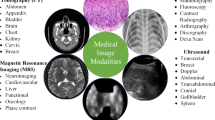Abstract
Background
Recently, artificial neural networks (ANNs) have been widely applied in science, engineering, and medicine. In the present study, we evaluated the ability of artificial neural networks to be used as a computer program and assistant tool in the diagnosis of obstructive sleep apnea (OSA). Our hypothesis was that ANNs could use clinical information to precisely predict cases of OSA.
Method
The study population in this clinical trial consisted of 201 patients with suspected OSA (140 with a positive diagnosis of OSA and 61 with a negative diagnosis of OSA). The artificial neural network was trained by assessing five clinical variables from 201 patients; efficiency was then estimated in this group of 201 patients. The patients were classified using a five-element input vector. ANN classifiers were assessed with the multilayer perceptron (MLP) networks.
Results
Use of the MLP classifiers resulted in a diagnostic accuracy of 86.6 %, which in clinical practice is high enough to reduce the number of patients evaluated by polysomnography (PSG), an expensive and limited diagnostic resource.
Conclusions
By establishing a pattern that allows the recognition of OSA, ANNs can be used to identify patients requiring PSG.



Similar content being viewed by others
References
Crocker BD, Olson LG, Saunders NA, Hensley MJ, McKeon JL, Allen KM, Gyulay SG (1990) Estimation of the probability of disturbed breathing during sleep before a sleep study. Am Rev Respir Dis 142(1):14–18. doi:10.1164/ajrccm/142.1.14
Hoffstein V, Szalai JP (1993) Predictive value of clinical features in diagnosing obstructive sleep apnea. Sleep 16(2):118–122
Sun LM, Chiu HW, Chuang CY, Liu L (2011) A prediction model based on an artificial intelligence system for moderate to severe obstructive sleep apnea. Sleep Breathing Schlaf Atmung 15(3):317–323. doi:10.1007/s11325-010-0384-x
Nakajima K, Matsuo S, Wakabayashi H, Yokoyama K, Bunko H, Okuda K, Kinuya S, Nyström K, Edenbrandt L (2015) Diagnostic performance of artificial neural network for detecting ischemia in myocardial perfusion imaging. Circ J. doi:10.1253/circj.CJ-15-0079
Serpen G, Tekkedil DK, Orra M (2008) A knowledge-based artificial neural network classifier for pulmonary embolism diagnosis. Comput Biol Med 38(2):204–220. doi:10.1016/j.compbiomed.2007.10.001
Kuruvilla J, Gunavathi K (2014) Lung cancer classification using neural networks for CT images. Comput Methods Programs Biomed 113(1):202–209. doi:10.1016/j.cmpb.2013.10.011
Takahiro S, Kinoshita K, Kishida S, Hirata Y, Yamada S (2012) Ensemble learning in systems of neural networks for detection of abnormal shadows from x-ray images of lungs. J Signal Process 16(4):343. doi:10.2299/jsp.16.343
Song Y, Crowcroft J, Zhang J (2012) Automatic epileptic seizure detection in EEGs based on optimized sample entropy and extreme learning machine. J Neurosci Methods 210(2):132–146. doi:10.1016/j.jneumeth.2012.07.003
Belciug S, Gorunescu F (2014) Error-correction learning for artificial neural networks using the Bayesian paradigm. Application to automated medical diagnosis. J Biomed Inform 52:329–337. doi:10.1016/j.jbi.2014.07.013
Waxman JA, Graupe D, Carley DW (2015) Real-time prediction of disordered breathing events in people with obstructive sleep apnea. Sleep Breathing Schlaf Atmung 19(1):205–212. doi:10.1007/s11325-014-0993-x
el-Solh AA, Mador MJ, Ten-Brock E, Shucard DW, Abul-Khoudoud M, Grant BJ (1999) Validity of neural network in sleep apnea. Sleep 22(1):105–111
Kirby SD, Eng P, Danter W, George CF, Francovic T, Ruby RR, Ferguson KA (1999) Neural network prediction of obstructive sleep apnea from clinical criteria. Chest 116(2):409–415
Hiestand DM, Britz P, Goldman M, Phillips B (2006) Prevalence of symptoms and risk of sleep apnea in the US population: results from the national sleep foundation sleep in America 2005 poll. Chest 130(3):780–786. doi:10.1378/chest.130.3.780
Liu J, Wei C, Huang L, Wang W, Liang D, Lei Z, Wang F, Wang X, Hou X, Tang X (2014) Prevalence of signs and symptoms suggestive of obstructive sleep apnea syndrome in Guangxi, China. Sleep Breathing Schlaf Atmung 18(2):375–382. doi:10.1007/s11325-013-0896-2
Marcos JV, Hornero R, Alvarez D, Del Campo F, Zamarrón C, López M (2008) Utility of multilayer perceptron neural network classifiers in the diagnosis of the obstructive sleep apnoea syndrome from nocturnal oximetry. Comput Methods Programs Biomed 92(1):79–89. doi:10.1016/j.cmpb.2008.05.006
Sériès F, Marc I, Cormier Y, La Forge J (1993) Utility of nocturnal home oximetry for case finding in patients with suspected sleep apnea hypopnea syndrome. Ann Intern Med 119(6):449–453
Financial/nonfinancial disclosures
Drs Karamanlı, Yalcinoz have reported that no potential conflicts of interest exist with any companies/organizations whose products or services may be discussed in this article.
Role of sponsors
The sponsors had no role in the design of the study, the collection and analysis of the data, or the preparation of the manuscript.
Conflict of interest
The authors declare that they have no conflict of interests regarding the publication of this paper.
Author information
Authors and Affiliations
Corresponding author
Additional information
The English in this document has been checked by at least two professional editors, both native speakers of English. For a certificate, please see http://www.textcheck.com/certificate/5KJUN6.
Rights and permissions
About this article
Cite this article
Karamanli, H., Yalcinoz, T., Yalcinoz, M.A. et al. A prediction model based on artificial neural networks for the diagnosis of obstructive sleep apnea. Sleep Breath 20, 509–514 (2016). https://doi.org/10.1007/s11325-015-1218-7
Received:
Revised:
Accepted:
Published:
Issue Date:
DOI: https://doi.org/10.1007/s11325-015-1218-7




